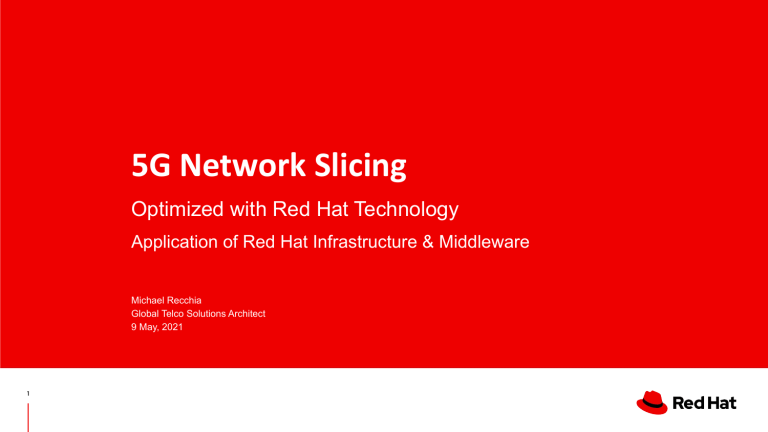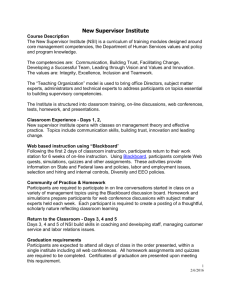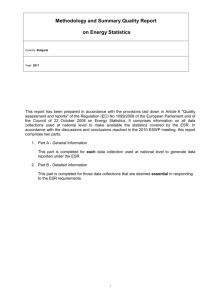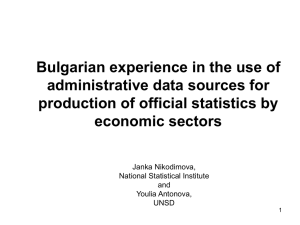
5G Network Slicing Optimized with Red Hat Technology Application of Red Hat Infrastructure & Middleware Michael Recchia Global Telco Solutions Architect 9 May, 2021 1 Definitions & Assumptions ●Critical Functions are implemented on “Carrier Grade” Cloud infrastructure (CGCI) ○ “Cloud Infrastructure” such as OpenShift, Kubernetes K8s ○ Multi-Access Edge Cloud (MEC) ○ RAN Intelligent Controller (RIC) ○ Virtual RAN (vRAN) ○ (v/c)NFs on Virtual Machines (VMs) or Containers ●A RIC (specified by the ORAN-Alliance) is integrated with the MEC and vRAN ○ The RIC contains micro-services (xApps, rApps) and AI/ML components for RAN Optimization and Management ○ RAN Optimization occurs per service slice or in the aggregate ●”Service Slices” are defined by the Mobile Network Operator (MNO, MVNO) or Customer (Enterprise) ○ The MEC contains Apps (micro-services) driven by MNO or Enterprise value-added use cases ○ Use Cases fall within URLLC, mMTC, eMBB categories ●“Orchestration” functions include: ○ VNF/CNF instantiation and stitching ○ App instantiation ○ Service chaining, configuration and stitching for NFs and other devices ○ RRU/BBU or O-RAN decomposed O-RU, O-DU, O-CU static and dynamic configuration ○ Transport instantiation and config (Front-Haul, Mid-H, Back-H, IP Core Xport) 2 Software Defined Networks Network Resource Multiplexor What is a “Network Slice” in 5G? A software-defined (SDN) “overlay” on the network infrastructure (i.e., a VPN) ● An instance of a Network Slice per 3GPP is a “Network Slice Instance”, or NSI ● An NSI is constructed by combining subnets, referred to as Network Slice Subnet Instances (NSSI) ○ ● NSSI are Compute, Storage, & Network resources ■ E.g., Network Functions, Logical constructs, such as ports & links, microservices, apps ■ These are modeled via a “template” describing subnet attributes NSSI and NSI can be modeled and constructed via an Orchestration system (e.g., ONAP) Each NSI focuses on particular use cases and has its own SLA/QoS/QoE ● Example NSI: ○ DoD – Enhanced battlefield situational awareness via equipment/personal IoT ○ Law Enforcement – City surveillance enhancement via multiple cameras, sensors, IoT worn by officers ○ Traffic Regulation and Policing ■ Change street lights based on actual traffic vs. TOD only ■ Improved throughput on highways via use of intelligent cars (Autonomous Vehicles) ○ FAA – Improved field of vision/situational awareness on runways NSSI1+NSSI2+...+NSSIN 5GC+5G EPC (Carrier or Private) Law Enforcement Slice (mMTC) Network Slice Instance (NSI) Traffic Regulation Slice (mMTC, URLLC) O-RAN O-RAN Runway Situational Awareness (mMTC) Battlefield Situational Awareness (mMTC, URLLC) Pharma Drone Delivery Services (mMTC) 4 Enterprise Verticals Network Slice Request RAN Optimization for Vertical Service Vn Enterprise/Telco Verticals Run [ xApps (Vn, E2) ] Microservices Vn Near-RT RIC Multiaccess Edge Cloud (MEC) O-RAN Radio Edge Cloud (REC) E2 Interface (Offloaded Signaling & Data) Primitives for RAN Optimization Bearer (User Plane, UP) O-CU/DU O-CU/DU O-RAN Compliant vRAN (eNb, gNb) O-RU OTA IoT/UE Limited NSSI in 3GPP Network Slicing Spec User Equipment (UE) Limited to 2-Tuple (Service Type, Differentiator) Subscription Database S-NSSAI NSIx(ServiceType, Differentiator) ● ● ● ● ● NSSI NSSI NSIx/Service Type 5G Network S-NSSAI: Single-Network Slice Selection Assistance Information NSSF: Network Slice Selection Function NSI: Network Slice Instance Service Type: Defines expected network slice behavior, depending on its specific features and service(s) ○ eMBB, mMTC, URLLC Currently vendors & Telcos are using “Orchestration-based” slicing because of 3GPP limitation NSSF Network Slicing Extensions beyond 3GPP NSSI Modeling for xApps, MEC Microservices, xHauls ● Current 3GPP Specs for Slicing are Limited ○ NSI is currently a 2-Tuple (Service Type, Differentiator) ○ MNOs/MVNOs/Enterprises need to include “extensions” ■ NSI (Service Type, Differentiator, Extensions) ■ ■ ○ Extensions include xHaul bandwidth, MEC microservices, REC xApps NSSI “templates” should allow for customization to include any network subnet Early Network Slicing POCs are/were performed with “Orchestration-based” capability ■ NSSI for RAN, MEC, REC, Transport are modeled and “pushed” to the network Front Haul NSSI Extension RU 7 NSSI defined for Network Element Bandwidth RIC xApp NSSI Ext. Mid Haul NSSI Ext. DU CU RIC xApp NSSI Ext. Back Haul NSSI Ext NF NF Core MEC uService NSSI Ext. NF NSI Component Breakdown An NSI is an SDN with its own service offerings built from NSSI and a particular Service Profile ● NSI = [ (NSSI1 || NSSI2 || ….. || NSSIn), Service Profile ( CoS[], QoE[], SLA[] ) ] ● Service Type/Profile () ○ A unique set of services independent of other NSI and the physical network ○ Custom CoS/QoE, Performance and reliability SLAs ○ Requires its own set of FCAPS in addition to the physical network FCAPS ○ Realized via Slice as a Service (SlaaS), Slice as Infrastructure, or defined via a central OSS/Orchestration system ○ Typically managed by an MVNO (Mobile Virtual Network Operator) Figure 3rd Generation Partnership Project, Technical Specification Group Services and System4.4.1.1 Aspects;Management and orchestration, Concepts, usefrom cases and requirements, TS 28530 8 NSSI Examples Network Slice NSSI Legend: Reserved resources from the RAN, vRAN, 5GC, EPC ● Examples: ○ A unique UPF instance at an edge location supporting a particular NSI’s data plane for URLLC services ○ vRAN logical ports (e.g., x.y, VLAN ID) reserved for an NSI over which that NSI’s services flow Extensions defined by the carrier ● U E RU x.y Front-Haul x.y DU E2 x.y Mid-Haul Mid-Haul Examples: ○ Backhaul Ethernet Virtual Circuit (EVC) assigned to a particular NSI E2 ■ E.g., a Verizon IEN EVC, an AT&T IPAG EVC ○ A specific MEC microservice used to provide a x x particular NSI’s service(s) A A ○ A specific RIC xApp designated to provide a p p p p particular RAN optimization for a given NSI’s 2 1 service(s) Red Hat Radio x.y EVC x.y CU B a c k H a u l x.y UPF x A p p n N9 M S 1 M S 2 M S n MEC Edge Cloud N3 N6 UPF RH OpenShift 9 Telco/MNO E2E View of Network Slicing * SLaaS 10ms-25ms RTT RAN Network Slice Subnet Instance (NSSI) vRAN NSSI RIC MEC Transport EPC/5GC NSSI NSSI NSSI Network Slice Instance (NSI) *Mademann, Frank. (2017). 3GPP System architecture milestone of 5G Phase 1 is achieved”, https://www.grandmetric.com/2018/03/02/5g-core-network-functions/ 10 DN Network Slicing Products ● Orchestration-Based Slicing Products ○ Ericsson ○ ZTE ○ Viavi ○ Nokia/Cloudstreet Dynamic Profile Controller (NPC) ○ Ciena Blue Planet ○ 11 *Depending on the carrier, some assets may be owned and/or managed by other entities based on a prior business arrangement, such as RAN Sharing. Network Slicing with Red Hat Technologies Performance Challenge: “5G Slice on Cloud” Legacy Stack Network Application Stack (e.g., 5G, VPN) ASIC-driven Network Elements Real Time (RT)-OS/Line Cards Links (e.g., Fiber) ● ● ● Network Slicing is built on an underlying cloud layer. The cloud layer & below must not add significant latency, nor decrease expected bandwidth, nor decrease massive IoT density. ○ Example: 5G mmWave bands enable <1ms RTT latency from Edge to/from UE via OTA (Over the Air). UE stack and Edge/O-RU/O-DU stack must be lightweight in order not to defeat the <1ms KPI. Red Hat addresses the performance challenge; Red Hat OpenShift, lightweight container platform, up to “6-Nines” availability, resiliency, ultra-low latency data bus, and other Red Hat components add value by enabling & preserving anticipated 5G KPIs. Cloud-based Stack Network Stack (vRAN, xApps/RIC, etc.) Cloud Stack General Purpose Operating Systems (e.g., Linux) COTS (e.g., x86) Links (NIC, Ethernet, Fiber) Network Slice NSI (NSSI,..,NSSI) ● Containers (vRAN, xApp. MEC uSVC) ● Transport, xHauls OpenShift RHEL CoreOS Smart NIC <1ms RTT Dell/HP/OpenEdge eCPRI/Ethernet/Fiber O-RU/mmWave Massive IoT Density: 1x106 devices per km2 UE/IoT Devices Monetization via Network Resource Multiplexing National Data Center Regional Data Center Urban/Suburban/Local Data Center Orchestration and Automation Infrastructure uSvc uSvc uSvc MEC xApp xApp xApp Radio EC OpenShift SLaaS O-RU O-RU O-RU OpenShift O-RU O-RU O-RU O-DU O-DU O-CU O-CU O-CU O-DU NF OpenShift OpenShift 5G Option 3x NSA EPC NF O-DU O-DU O-DU NF NF NF OpenShift O-RU O-RU O-RU OpenShift NF O-DU O-DU O-DU xApp xApp NF xApp Radio EC 5G Option 2 SA Core OpenShift Red Hat OpenShift/Openstack and OS RHEL Infrastructure NF Orchestration and Automation QoSA Slice1 QoSB QoSC Slice2 QoSD vRAN Segment (O-RU, O-CU, O-DU) Edge Cloud Segment VPN Transport Segment MEC uSvc UPF VPLS xApp RIC Slice1 REC QoSE QoSF Slice3 vRAN Segment MEC uSvc UPF Cloud Infra Slice2 UPF: User Plane Function vCore Segment CNF Slice3 Cloud Infra Red Hat Openshift Container Platform, Red Hat Openstack Platform CNF: Core Network Function Orchestration-based slicing CNF Cloud Native Apps CNF Cloud Infra Red Hat Openshift Container Platform, Red Hat Openstack Platform VPLS: Virtual Private LAN Service Proposed ONAP-Based NSI/NSSI Software Stack NSI/NSSI Modeling using ONAP with E2E BSS/OSS Integration Dashboard/API Orchestration Certification Design & Creation Lifecycle 5G Slice Services (e.g., Gaming, AV, VR, 360Video) E2E Network Slice Instances (NSI) RAN NSSI MEC NSSI MEC/REC Model vRAN Model MEC Orchestration MEC / cloud NFVI management 5G UEs EDGE MEC ORAN Model Core NSSI Transport NSSI NWDAF Transport Model 5G Model 4G Model NWDAF Red Hat Cloud and OS Models Non-Real-time, event and performance collection and centralized processing for Assurance/LCM Real-time, event and performance collection & local processing. Offload core by sending up insights not raw data RAN CORE 3rd Party Cloud Services Cloud-Based EDGE Network Slice Management MNO, MVNO, Enterprise NSI Phases from TR 28530 Release 15 Network Slicing Mobile Network Operators and Network Slice Operators ● Mobile Network Operators (MNO) ○ “Typically” operates and manages all network assets (sw + hw)* ○ Typically has allocation rights for all network assets* ○ “All network assets” in reality means the “network infrastructure as a whole”, prior to any NSI (VPN) definitions ○ The allocation of NSI resources are at the discretion of the MNO ● A “Mobile Virtual Network Operator (MVNO)” or Enterprise would typically manage an NSI ○ An enterprise that “purchases” or “leases” a “slice contract” from an MNO is an MVNO ○ An MVNO “typically” operates and manages the virtual entities comprising the NSI* ○ The design of a particular NSI depends on the business model between an MNO and MVNO (or Enterprise) ■ An MVNO would negotiate with the MNO for the set of services and the Classes of Service (CoS) needed for their NSI(s) ■ Generally, higher CoS for an NSI dictates the allocation of more resources by the MNO ■ Depending on the business model/agreement, the MVNO may take on operation and management of some physical assets (e.g., Far Edge uCPE/Whitebox) 19 *Depending on the carrier, some assets may be owned and/or managed by other entities based on a prior business arrangement, such as RAN Sharing. Federated Management Model ● “Federated” OSS & BSS functions ○ ○ ● OSS-Central (OSS-C) focused on Non-RT FCAPS (>200ms)* ■ Legacy functions, such as Billing, Cap Mgmnt ■ NSI design, NSSI modeling, NSI orchestration OSS-Local (OSS-L, distributed) ■ Focuses on data mediation ● offload/aggregation, insight generation toward OSS-C ■ Low-latency closed-loop control ■ Other latency sensitive operations ● Operations requiring RT (<=20ms) or Near-RT (<=100-200ms) latency (Edge or Far-Edge)* ○ E.g., Video Rendering Management Demarcation ○ MNO and MVNOs (Enterprises) will do parts of OSS-C and OSS-L ○ Examples: ■ MVNOs may have their own Billing systems for an NSI’s services ■ MNO will bill MVNOs based on the business model for NSI allocations ■ MVNOs may provide video rendering services for their “Gaming” NSI *All latency numbers are Round Trip Time (RTT) including SOL and node processing times. 20 OSS Future Mode of Operation (FMO) with Network Slicing • • • Distributed OSS Model • OSS-Central, OSS-Local • Proposed NSI stack OSS-C (NSI Design and Creation, Non-RT FCAPs, Planning) OSS-C Role • E2E Network Slice Instance (NSI) Design, Creation and NSI/NSSI Push Lifecycle • NSI Non-RT FCAPS, Planning • Network Non-RT FCAPS OSS–L Role • OSS-C data offload • FCAPS of low-latency NSSI components within the Edge RAN Data Mediation OSS-L vProbes vProbes MEC Value-Add Apps vRAN AI/ML RIC NSI: E2E Service Overlay (eMBB, URLLC, mMTC) MEC Infrastructure Stack IEN (Backhaul) 4G/ 5G Core 21 OSS NSI Life Cycle Model using OSS-C & OSS-L • • • • • • • • • • • • • • • • • • • Network Slice Instance (NSI) Design & Creation Ordering Deployment (Orchestration) Customer Provisioning Service Assurance Performance Capacity Management Planning Business Planning Low latency MEC App Instantiation & FCAPS Performance data/processing offload from OSS-C RAN Optimization ORAN RAN Intelligent Ctrl (RIC) (e.g., Beam Forming, ANR, DC) Low latency Closed Loop for NSSI resources (e.g., Fast Switch) Local vProbe & Automated Troubleshooting Local app data rendering (e.g., gaming video) Transport QoS setting and validation Processing of vRAN UE Measurements and Events Edge Learning and Response via AI, ML Service chaining at the edge (e.g., UPF🡪MEC App🡪RIC App--vRAN) Data aggregation and mediation to OSS-C NSI FCAPS NSI Customer Experience Analytics NSI RAN Analytics OSS-C(entral) Non-Real Time (>100ms) Life Cycle RTT NSI KPI Analytics NSI UE Measurements NSI RAN Events OSS-L(ocal) Real Time (<=20ms) Near Real Time (<=100ms) RTT NSI RAN Optimization RIC Events MECOffload Data Data 22 Example OSS/BSS Architecture with O-RAN RIC NSI Integration OSS-C/BSS-C • ONAP-Local (Map xApp to Slice) O1 A1 OSS for FCAPS (NSI Def) OpenShift EdgeCloud O-RAN RIC • FCAPS Agent A1 interface • CEPH Service Slice functions Persistene database Conflict resolution S l i c e 1 S l i c e 1 S l i c e 2 S l i c e 3 µservices RIC Slicing via xApps • • R-NIB Policy & control xApps • Policy … • (multi-vendor) µservice registry Platform & interface security Pub/sub Control Kubernetes Service bus (e.g., D-Bus) E2 mediation data control E2 UE Measurement Data UE/xNB Events • • Signaling (e.g., E2 Connection Mgmnt) • VRAN (O-RU, O-DU, O-CU) OpenShift vRAN Cloud Carrier-grade EdgeCloud (e.g., OpenShift) RIC xApps, MEC Mservices mapped to SliceN by ONAP-L (e.g., 2 xApps in 1 Slice) Each “Slice” disaggregates vRAN CP/UP components to provide differentiated RAN optimization per SliceN Focus on RT & Near-RT Low-latency use cases • E.g., ANR which may require RT or NRT latency (<=10ms) • E.g., Dual Connectivity, Beam Forming ONAP-Local • 23 Focus on infrastructure and NSI def, NSI orchestration and FCAPS RIC xApps, MEC micro-services mapped to SliceN by ONAP-L Orchestration is Non-RT but services orchestrated may be RT or Near-RT in nature (e.g., AV, Robotic Surgery) Slice configs “Pushed” to MEC • • Low latency Closed-Loop-Orchestration, Management Manage O-RAN and vRAN via standard ORAN/xRAN interfaces (A1, O1, E1, E2) Shares management responsibility with OSS/BSS Data Mediation, Insight Generation Policy, xApp to Slice mapping Example NSI: Improving Performance of Network Beam Steering using mmWave and Massive MIMO • Multiple Input Multiple Output Antenna at Macro-cell • Use Network of Smart-repeaters and/or Small-cells to route around obstacles or “bad links” • Beam Forming and Steering per UE 🡪 Network Beam Steering where obstacles, blockage, refraction, dispersion are problematic NSSI5 5GC NSSI2 NSSI2 O-CU O-DU NSSI3 oru O-RU R1 R2 ● Re-Route xApp Use modified “Handover” procedure xApp NSSI1: Re-Route xApp 24 R22 UE NSSI0 E2 ● NSSI1 = RIC Re-Route xApp NSSI2 = O-CU and/or O-DU port bandwidth (e.g., Port 1.x, where x = logical sub-port) ● NSSI3 = O-RU port bandwidth ● NSSI4 = UE NSI Application ● NSSI5 = Core Network Function(s) needed ● NSSI6-8 = Front, Mid, Back Haul ● NSSI0 = R1-R32 = Intelligent Repeaters/Micro-Cells/Smallcells path to UE App ● R3 RIC R12 R32 ● Cyber Security in 5G NSI ▪ Vertical Security via Slicing: Distinct Virtual Networks – Physical infrastructure is multiplexed into virtual Network Slice Instances (NSI) ▪ MNOs/MVNOs want to monetize the network via Virtual Network Slices – Network Slices minimize or eliminate common data structures between NSI – Hardware and Firmware commonality between NSI is easier to firewall – Each NSI maintains a unique set of SLAs, QoS, CoS, and FCAPS ▪ Horizontal Security: – 5G UP & CP Encryption ▪ Protection against eavesdropping and modification ▪ Signaling traffic and bearer data is encrypted • Encryption based on SNOW 3G, AES-CTR, and ZUC • Key generation based on HMAC-SHA-2569 – New Integrity Protection ▪ Based on SNOW 3G, AES-CMAC, and ZUC ▪ Applies to small, bursty data as would be expected from IoT devices 25 Cyber Security in 5G (cont’d) ● Horizontal Security (cont’d) ●Identity Management ✔Secure methods for authenticating subscribers (apply to each NSI) ✔5G Authentication & Key Agreement (5G AKA) and Extensible Authentication Protocol (EAP) ✔MNO/MVNO determines authentication credentials, methods, and ID formats for subscribers (incl devices) ✔Previous releases required SIM cards ✔5G accepts certificates, pre-shared keys token cards, and other objects ✔EAP allows for different authentication protocols and credential types without affecting intermediate nodes ●5G inherits Equipment Identity Register (EIR) ✔Prevents stolen devices from using network services ●Subscriber Presence Validation ✔MNO/MVNO validates subscriber presence during authentication (including Roaming) ✔Identifies and mitigates fraud for the Carrier/Operator and the subscriber 26 Backup 27 28 5G Service Slicing - Definitions ▪ NSI (Network Slice Instance): Virtual service overlay on a common physical network. – Each NSI provides a specific service capability that is isolated as a logical entity from other Slices. For example, VoLTE can be considered a service slice over a physical LTE network. – Physical and logical resources can be dedicated to particular slices. – Network Functions (NFS) from the 5G 3GPP reference architecture are arranged E2E in a slice. ▪ NSSI (Network Slice Subnet Instance): A subnet, such as RAN, and associated configurations as part of the E2E NSI definition. ▪ Micro-Services: A software architecture technique to instantiate service slicing. ▪ MEC: Mobile Edge Cloud or Multi-Access Edge Cloud. ▪ REC: Radio Edge Cloud ▪ ORAN: Open-RAN Alliance ▪ RIC: RAN Intelligent Controller, part of the ORAN specification ▪ 5Gc: The 5G Packet Core 29 CUPS ▪ Control and User Plane Separation (CUPS) architecture and spec completed in TR 23.714 and TS 23.214/23.244. ▪ CUPS enables scaling of UPF by architectural separation of control and user plane functions using Sx. – UPF can be distributed and deployed independently from the centralized control plane. – This includes on the MEC/REC and the Far Edge (Cloud). Edge Distribution of NFs Based on Service Slices 5G Core vRAN NIC Uu F1 SRIOV Uu RAP/DU NIC N1 SRIOV Viavi/Aeroflex Simulate up to 1500 UE UPF on edge RAP/DU F1 NIC SRIOV N2 NIC SRIOV Uu gNB cBTS-5G-18A /CU VNF SMF X2-CP vRAN Uu AMF/ MME N6 N1 N4 N2 N1 X2-UP NIC N1 SRIOV UPF NIC SRIOV MEC UE (Call Model) N3 N3 N1 AMF on edge UE (Call Model) 30 gNB N3 NIC cBTS-5G-18A SRIOV /CU VNF N2 N4 N1 UPF N2 N6 N3 NIC SRIOV N3 E2 DN Slices RIC e/gNb Dis-aggregation with Latency Optimization CO Other CU Low Functions Radio Heads Uu/OTA RAP ONAP-Local SO, SDNC, A&AI, DCAE F1 UP&CP cBTS E2 Slices RIC UP&CP cBTS E2 2ms MetroE Latency 2ms – 20ms RIC+ONAP-L Latency vRAN on EdgeCloud 2ms cBTS Latency <= 25ms RTT Latency (1+2+2+ 20) DataCtr to RAP/Tower 31 4GC CU-CP-H CO CU-Low <1ms DU Latency Akraino E2 CU-Low F1 UE DU DU F1 DU UP&CP-cBTS CO F1 F2 Data Ctr 5GC From AT&T RAN-Slicing POC using ONAP Slice2 Cell #4 Cell #1 Cell #5 Cell #2 Tracking Area #3 Tracking Area #1 Cell #6 Tracking Area #4 Slice1 Cell #3 Tracking Area #2 PLMN #1 PLMN #2 Thank you Red Hat is the world’s leading provider of enterprise linkedin.com/company/red-hat open source software solutions. Award-winning support, training, and consulting services make youtube.com/user/RedHatVideos Red Hat a trusted adviser to the Fortune 500. facebook.com/redhatinc 33 twitter.com/RedHat






